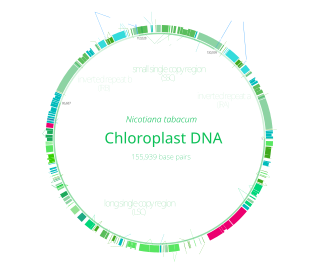This page is based on this
Wikipedia article Text is available under the
CC BY-SA 4.0 license; additional terms may apply.
Images, videos and audio are available under their respective licenses.

In the fields of molecular biology and genetics, a genome is the genetic material of an organism. It consists of DNA. The genome includes both the genes and the noncoding DNA, as well as mitochondrial DNA and chloroplast DNA. The study of the genome is called genomics.

Symbiogenesis, or endosymbiotic theory, is an evolutionary theory of the origin of eukaryotic cells from prokaryotic organisms, first articulated in 1905 and 1910 by the Russian botanist Konstantin Mereschkowski, and advanced and substantiated with microbiological evidence by Lynn Margulis in 1967. It holds that the organelles distinguishing eukaryote cells evolved through symbiosis of individual single-celled prokaryotes.

In molecular biology, a reading frame is a way of dividing the sequence of nucleotides in a nucleic acid molecule into a set of consecutive, non-overlapping triplets. Where these triplets equate to amino acids or stop signals during translation, they are called codons.
D-loop replication is a proposed process by which circular DNA like chloroplasts and mitochondria replicate their genetic material. An important component of understanding D-loop replication is that many chloroplasts and mitochondria have a single circular chromosome like bacteria instead of the linear chromosomes found in eukaryotes. However, many chloroplasts and mitochondria have a linear chromosome, and D-loop replication is not important in these organelles. Also, not all circular genomes use D-loop replication as the process of replicating its genome.
Heteroplasmy is the presence of more than one type of organellar genome within a cell or individual. It is an important factor in considering the severity of mitochondrial diseases. Because most eukaryotic cells contain many hundreds of mitochondria with hundreds of copies of mitochondrial DNA, it is common for mutations to affect only some mitochondria, leaving most unaffected.

Human mitochondrial genetics is the study of the genetics of human mitochondrial DNA. The human mitochondrial genome is the entirety of hereditary information contained in human mitochondria. Mitochondria are small structures in cells that generate energy for the cell to use, and are hence referred to as the "powerhouses" of the cell.
Extrachromosomal DNA is any DNA that is found outside the nucleus of a cell. It is also referred to as extranuclear DNA or cytoplasmic DNA. Most DNA in an individual genome is found in chromosomes but DNA found outside the nucleus also serves important biological functions.
Extranuclear inheritance or cytoplasmic inheritance is the transmission of genes that occur outside the nucleus. It is found in most eukaryotes and is commonly known to occur in cytoplasmic organelles such as mitochondria and chloroplasts or from cellular parasites like viruses or bacteria.
Chaetosphaeridium globosum is a one-celled alga which is thought to represent an ancient lineage of the green plants. This organism exists in a filamentous form with one flagella per cell. It is a freshwater species. The flagellum is covered in scales in a 3-prong irregular shape called ‘maple leafs’. The cells are usually 11–18 micrometres (0.00043–0.00071 in) in diameter and with one pyrenoid. Each cell bears long bristle.
NUMT, pronounced "new might," is an acronym for "nuclear mitochondrial DNA segment" coined by evolutionary geneticist, Jose V. Lopez, which describes a transposition of any type of cytoplasmic mitochondrial DNA into the nuclear genome of eukaryotic organisms.

ATP synthase subunit b, mitochondrial is an enzyme that in humans is encoded by the ATP5PB gene.

28S ribosomal protein S6, mitochondrial is a protein that in humans is encoded by the MRPS6 gene.

39S ribosomal protein L37, mitochondrial is a protein that in humans is encoded by the MRPL37 gene.

28S ribosomal protein S33, mitochondrial is a protein that in humans is encoded by the MRPS33 gene.

28S ribosomal protein S21, mitochondrial is a protein that in humans is encoded by the MRPS21 gene.

39S ribosomal protein L10, mitochondrial is a protein that in humans is encoded by the MRPL10 gene.
The CoRR hypothesis states that the location of genetic information in cytoplasmic organelles permits regulation of its expression by the reduction-oxidation ("redox") state of its gene products.

Coiled coil domain containing 90B, also known as CCDC90B, is a protein encoded by the CCDC90B gene.

Chloroplasts have their own DNA, often abbreviated as cpDNA. It is also known as the plastome when referring to genomes of other plastids. Its existence was first proven in 1962, and first sequenced in 1986—when two Japanese research teams sequenced the chloroplast DNA of liverwort and tobacco. Since then, hundreds of chloroplast DNAs from various species have been sequenced, but they are mostly those of land plants and green algae—glaucophytes, red algae, and other algae groups are extremely underrepresented, potentially introducing some bias in views of "typical" chloroplast DNA structure and content.
CGView is a freely available downloadable Java software program, applet and API for generating colorful, zoomable, hyperlinked, richly annotated images of circular genomes such as bacterial chromosomes, mitochondrial DNA and plasmids. It is commonly used in bacterial sequence annotation pipelines to generate visual output suitable for the web. It has also been used in a variety of popular web servers and databases (BacMap).













